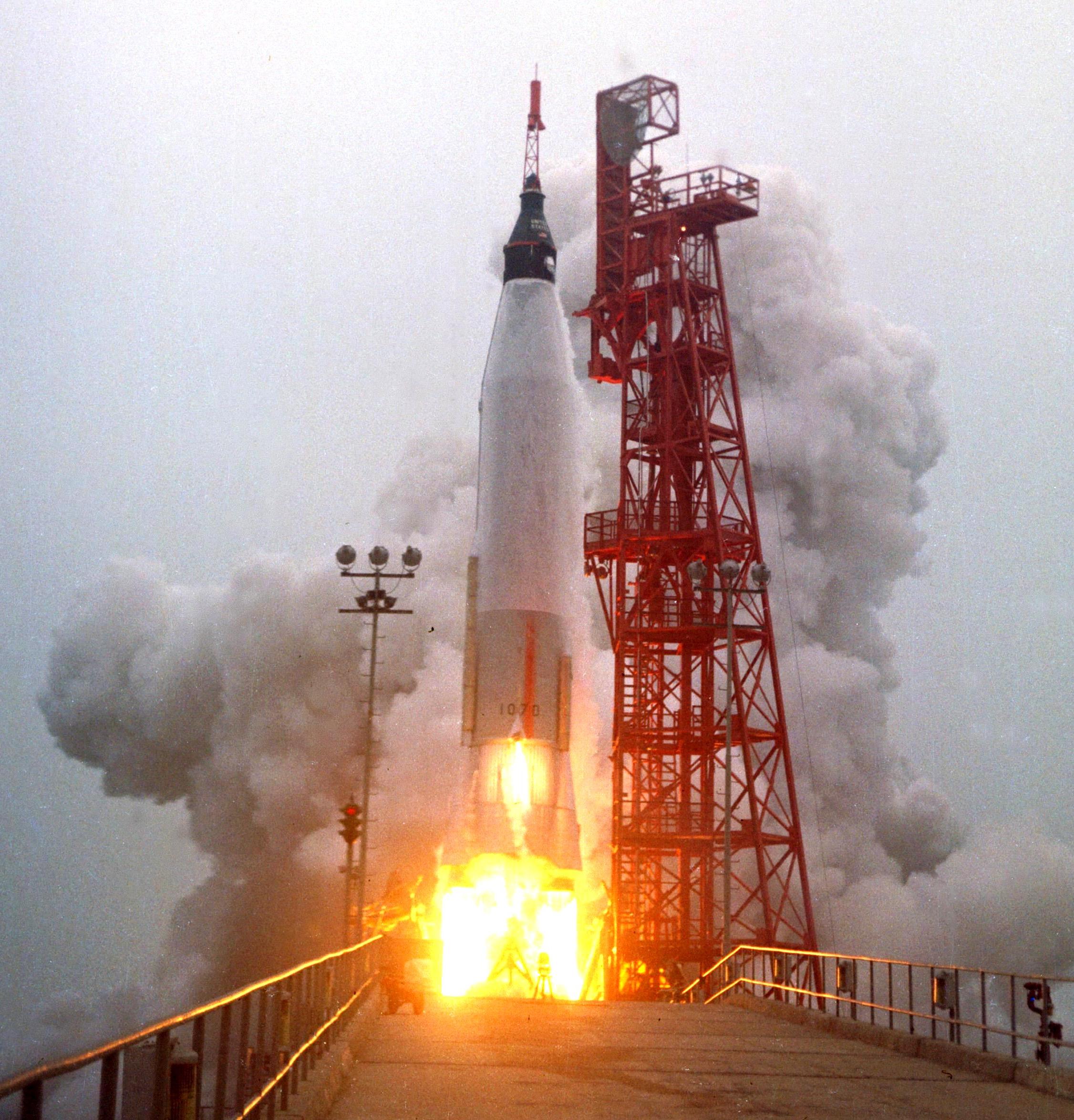
24 May 1962: Lieutenant Commander Malcolm Scott Carpenter, United States Navy, NASA Astronaut, was launched aboard Mercury-Atlas 7 at 12:45:16.57 UTC (7:45:16 a.m., Eastern Daylight Time) from Launch Complex 14 at the Cape Canaveral Air Force Station, Cape Canaveral, Florida. This was the fourth manned space flight of the American space program. Carpenter was the sixth human to fly in space.
Scott Carpenter reported,
When the ignition signal was given, everything became quiet. I had expected to feel the launch vehicle shake, some machinery start, the vernier engines light off, or to hear the lox valve make some noise, but I did not. Nothing happened until main engine ignition; then I began to feel vibration. There was a little bit of shaking. Lift off was unmistakable.
— RESULTS OF THE SECOND U.S. MANNED ORBITAL SPACE FLIGHT MAY 24, 1962, NASA SP-6. National Aeronautics and Space Administration, Manned Spacecraft Center, Project Mercury. Pilot’s Flight Report, Page 69, Column 2
According to the NASA post-flight mission report, “The performance of the launch vehicle was exceptionally good. . . .”
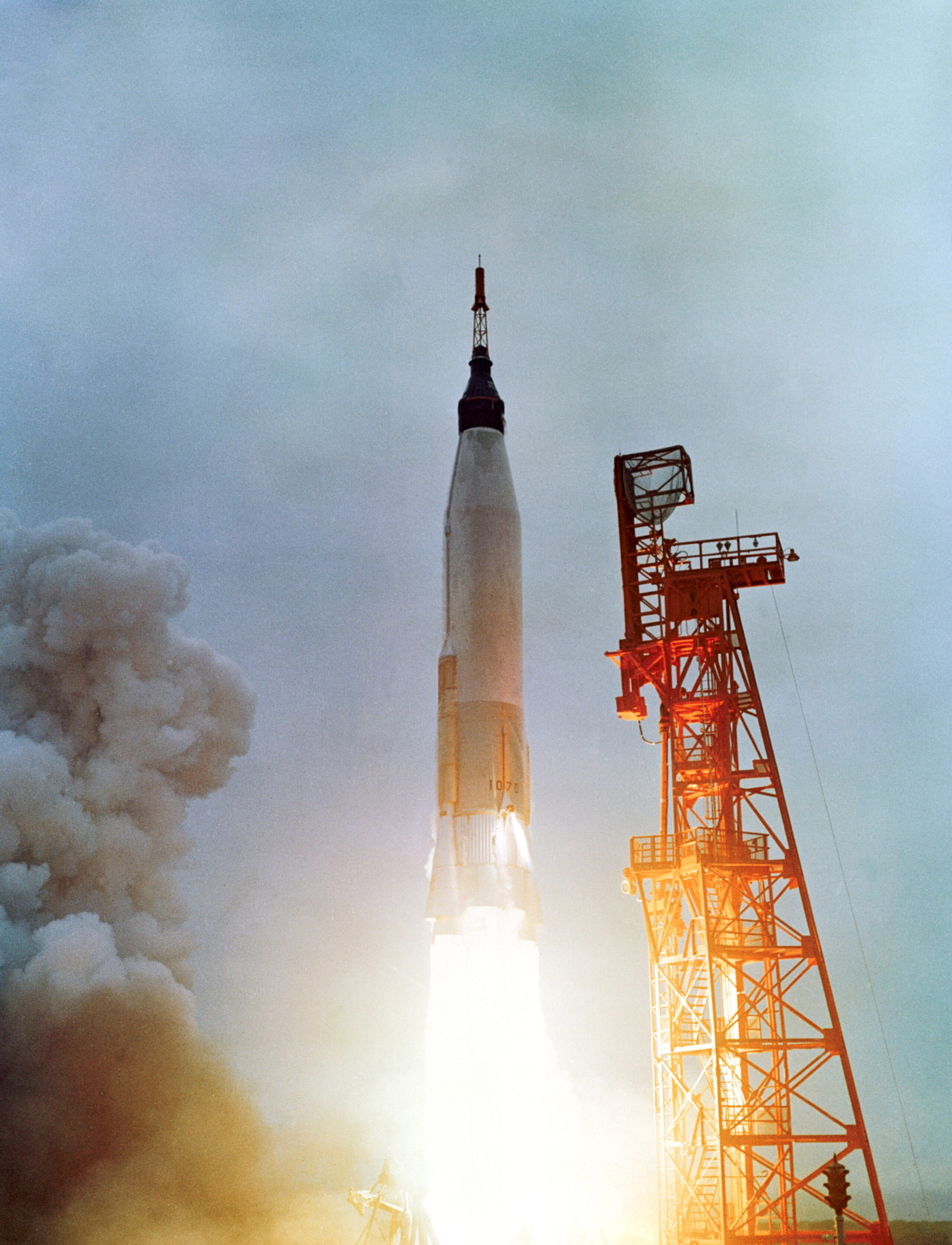
During the launch, Carpenter experienced a maximum of 7.8 gs acceleration. 5 minutes, 12.2 seconds after liftoff, Aurora 7 separated from the Atlas booster and entered Earth orbit, having reached a speed of 17,534 miles per hour (28,219 kilometers per hour). The orbit was elliptical, with a minimum altitude of 86.87 nautical miles (160.88 kilometers) and a maximum of 144.96 nautical miles (268.47 kilometers). Carpenter completed an orbit every 88 minutes, 32 seconds.
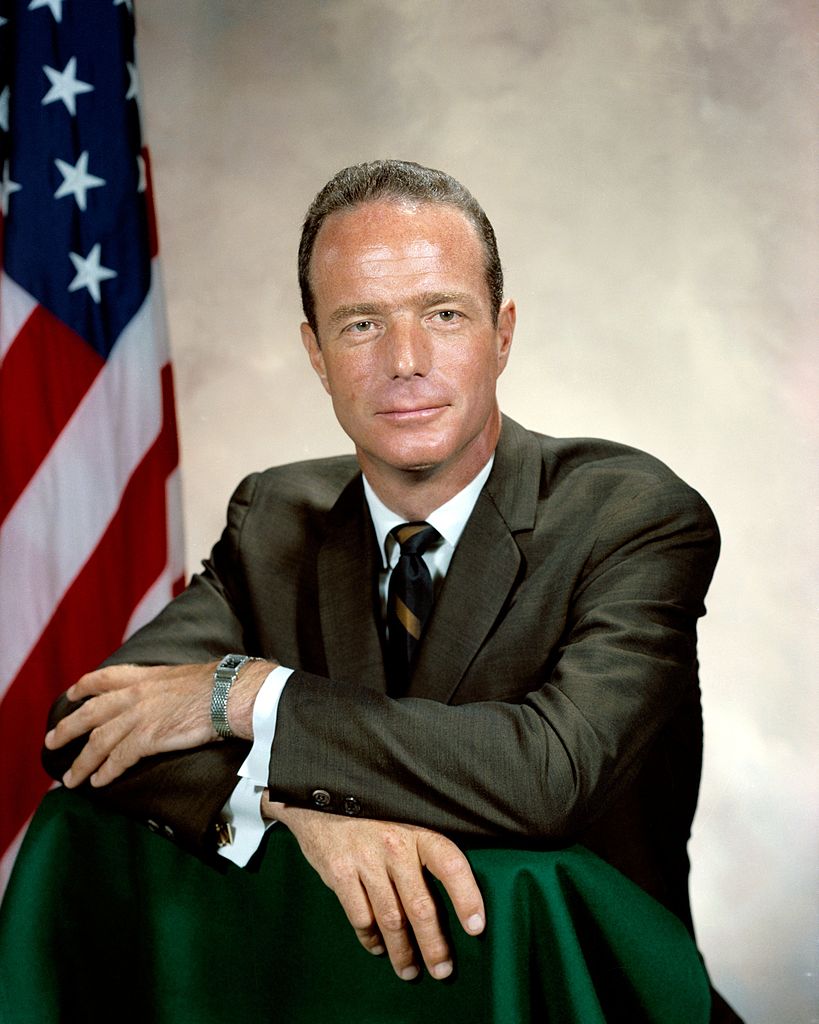
During the orbital phase of the mission, a pitch horizon scanner—part of the automatic flight control system—malfunctioned, causing the capsule’s attitude jets to fire to correct perceived errors in the ship’s attitude. This caused an excessive consumption of the hydrogen peroxide fuel for the reaction controls.
At T+04:30:00 (four hours, thirty minutes after launch) the Mercury capsule’s retrorockets fired to slow the capsule and begin the reentry phase of the flight. Each of the retro rockets fired at 5 second intervals and burned for 10 seconds. The capsule decelerated 550 feet per second (168 meters per second) and fell out of orbit. The PHS failed again, yawing Aurora 7 25° off track, which prevented the full thrust of the retrorockets from being directed along the correct path. Scott Carpenter had to fire the rockets manually, resulting in a 3 second delay, and this, along with the misalignment of the capsule, caused Aurora 7 to overshoot the planned splashdown point in the Atlantic ocean by approximately 250 nautical miles (288 statute miles/463 kilometers). (N. 19° 27′, W. 63° 59′)
At 10,000 feet (3,048 meters) Aurora 7‘s main parachute opened. The spacecraft “splashed down” at 17:41:21 UTC. The total duration of the flight was 4 hours, 55 minutes, 57 seconds.
Scott Carpenter was hoisted aboard a Sikorsky HSS-2 Sea King helicopter from USS Intrepid (CVS-11). Aurora 7 was recovered by the Allan M. Sumner-class destroyer, USS John R. Pierce (DD-753), 6 hours after its landing.
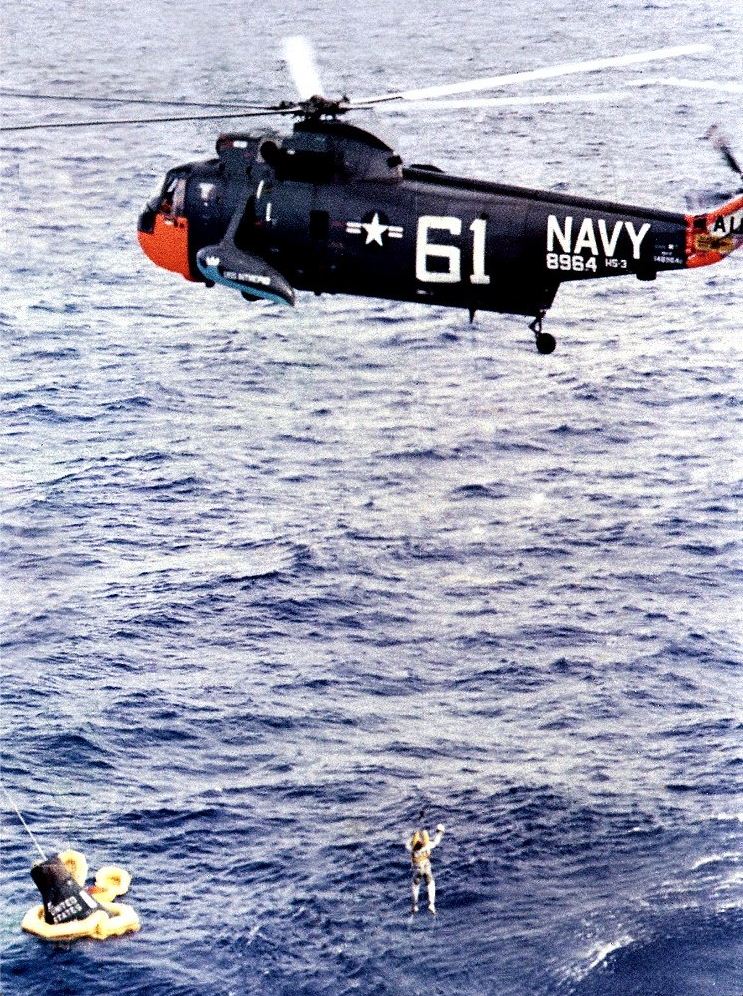
The flight of Scott Carpenter and Aurora 7 was a success, but Carpenter was subject to criticism for his performance during the mission.
In 1963, Carpenter was injured in a motorcycle accident and lost some mobility in his left arm. Despite two surgical procedures, it was determined that he was ineligible for spaceflight. He resigned from NASA in 1967 and retired from the U.S Navy in 1969 with the rank of Commander.
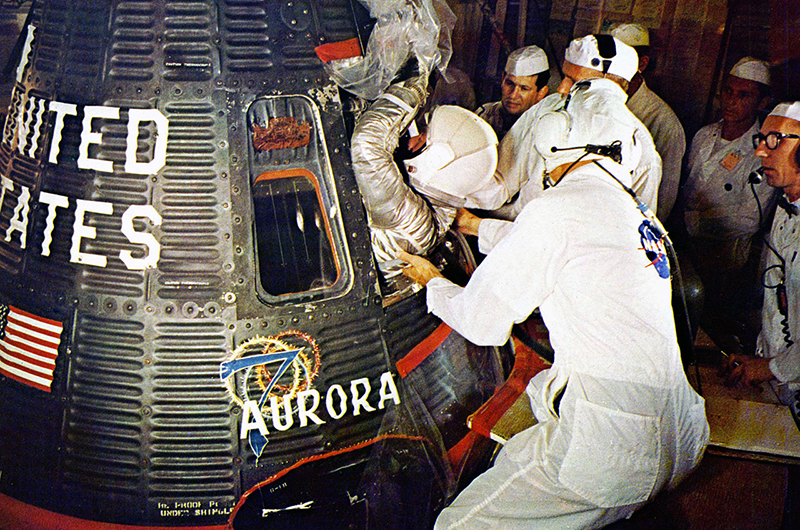
![]() Mercury 18, named Aurora 7 by Carpenter, was built by McDonnell Aircraft Corporation, St. Louis, Missouri. Designed to carry one pilot, the Mercury space craft could be controlled in pitch, roll and yaw by thrusters. The space capsule was truncated cone with sides angled 20° from the longitudinal axis. It was 6 feet, 10 inches (2.083 meters) long and had a maximum diameter of 6 feet, 2.50 inches (1.892 meters). The total height of the spacecraft, from the tip of the aero spike to the booster adapter, was 26 feet, 1.26 inches (7.957 meters). Aurorra 7 weighed 4,244.09 pounds ( kilograms) at Launch.
Mercury 18, named Aurora 7 by Carpenter, was built by McDonnell Aircraft Corporation, St. Louis, Missouri. Designed to carry one pilot, the Mercury space craft could be controlled in pitch, roll and yaw by thrusters. The space capsule was truncated cone with sides angled 20° from the longitudinal axis. It was 6 feet, 10 inches (2.083 meters) long and had a maximum diameter of 6 feet, 2.50 inches (1.892 meters). The total height of the spacecraft, from the tip of the aero spike to the booster adapter, was 26 feet, 1.26 inches (7.957 meters). Aurorra 7 weighed 4,244.09 pounds ( kilograms) at Launch.
 The rocket, a “1-½ stage” liquid-fueled Atlas LV-3B, number 107-D, was built by the Convair Division of General Dynamics at San Diego, California. It was developed from a U.S. Air Force SM-65 Atlas D intercontinental ballistic missile, modified for use as a “man-rated” orbital launch vehicle.
The rocket, a “1-½ stage” liquid-fueled Atlas LV-3B, number 107-D, was built by the Convair Division of General Dynamics at San Diego, California. It was developed from a U.S. Air Force SM-65 Atlas D intercontinental ballistic missile, modified for use as a “man-rated” orbital launch vehicle.
The LV-3B was 65 feet (19.812 meters) long from the base to the Mercury adapter section, and the tank section is 10 feet (3.038 meters) in diameter. The complete Mercury-Atlas orbital launch vehicle is 93 feet (28.436 meters) tall, including the escape tower. When ready for launch it weighed approximately 260,000 pounds (117,934 kilograms).
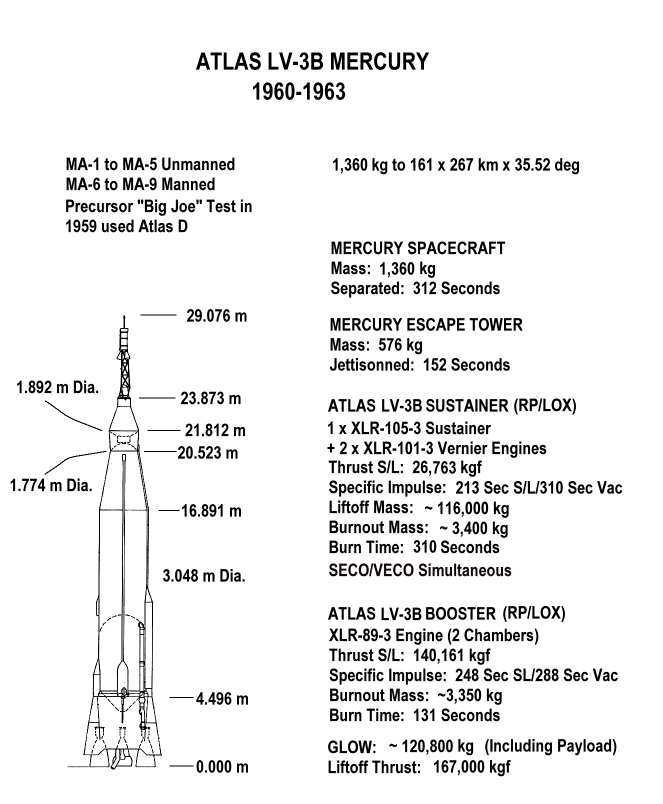
 The Atlas’ three engines were built by the Rocketdyne Division of North American Aviation, Inc., at Canoga Park, California. Two Rocketdyne LR89-NA-5 engines and one LR105-NA-5 produced 341,140 pounds (1,517.466 kilonewtons) of thrust. The rocket was fueled by a highly-refined kerosene, RP-1, with liquid oxygen as the oxidizer.
The Atlas’ three engines were built by the Rocketdyne Division of North American Aviation, Inc., at Canoga Park, California. Two Rocketdyne LR89-NA-5 engines and one LR105-NA-5 produced 341,140 pounds (1,517.466 kilonewtons) of thrust. The rocket was fueled by a highly-refined kerosene, RP-1, with liquid oxygen as the oxidizer.
Malcolm Scott Carpenter died 10 October 2013 at the age of 88. His spacecraft, Aurora 7, is on display at the Chicago Museum of Science and Industry, Lakeshore Drive, Chicago, Illinois.
© 2019, Bryan R. Swopes